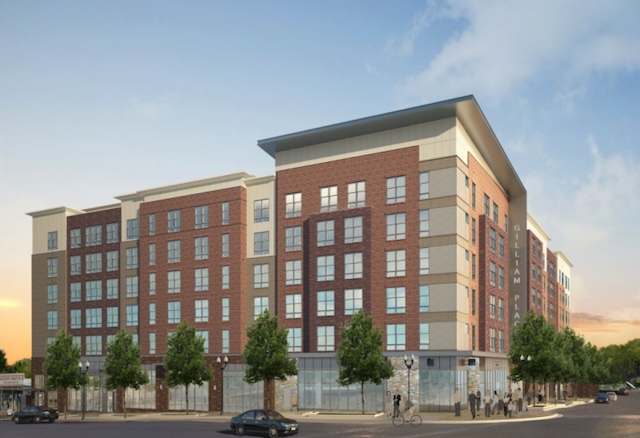Affordable housing projects aren’t making housing more affordable. In fact, says a new study by an MIT economist, construction of new subsidized housing displaces new unsubsidized housing for little net gain in the housing supply. Specifically, the study found, ten new subsidized housing units resulted in eight fewer unsubsidized units.
This is supposed to be an affordable housing project, yet it is already unaffordable because it is six stories high, which costs at least twice as much to build, per square foot, as two-story construction.
Between 1950 and 1986, most subsidized housing was built by government agencies. In 1986, a Republican Congress sought to “privatize” the construction of subsidized housing by giving developers tax credits if they promised to rent their housing at below-market prices for 30 years. Today, low-income housing tax credits worth around $10 billion a year are given to the states to hand out to developers. To see how well this program is working, economist Evan Soltas looked at hundreds of projects built with tax credits.
He found that, due to displacement of private construction, affordable housing projects effectively cost taxpayers $1 million for each net new unit of housing. About 44 percent of the benefits of such subsidies go straight to the developers, while the low-income renters get only 31 percent.
If there is any positive benefit of such projects, he says, it is that they shift those who rent new units to lower income households. However, he shows that the same benefit can be obtained at a far lower cost by using voucher programs such as Section 8.
Soltas doesn’t mention it, but the first projects that received low-income housing tax credits were built 35 years ago. That means at least five years of such projects no longer have to be rented at below-market rates. New projects built today not only displace new unsubsidized units, they are merely replacing older subsidized housing whose 30-year rent restriction period has expired. Thus, affordable housing programs are running as fast as possible (meaning spending as many taxpayer dollars as possible) to merely stay in one place.
The low-income housing tax credit program was well intentioned, but no one in the housing bureaucracy has bothered to question whether it has been successful. Instead, many state housing planners use it to promote social engineering, namely by trying to force more people to live in high-density housing that most Americans try to avoid even though that high-density housing is more expensive than the low-density housing Americans prefer. It is time to abolish affordable housing programs and deal with housing affordability by directly fixing the causes of high housing prices, namely urban-growth boundaries and other forms of growth management.









We have affordable housing it’s called Nevada.
Years ago a news article said it’d be cheaper to fly vegas to SF for work daily than live in San francisco……
More ammusingly the BBC series Top Gear, tried social experiment in private train using cars modded to track and caravans…..
To quote a genius… how hard can it be
https://www.youtube.com/watch?app=desktop&v=mkpCzp0CmjY
Without thinking much about it, most people prefer traditional architecture and traditional housing stock.
It’s no surprise in New Orleans epicenter of bad public housing and affordable housing projects.
In the middle city lie Iberville housing projects, build in 40’s, The Iberville Project consisted of seventy-five brick buildings with 858 apartments. It was designed to blend in with the old neighborhood’s housing in terms of proportionality, size, and style, resembling rowhouses of the 19th century. Unlike other projects, there is far less crime and vandalism. Because it resembles the housing stock people would pay millions to buy as a townhouse.
Sprawl advocates use density as an argument for more segregated housing types which many have used for decades to keep out social riff raff. Suburbs are prone to same urban decay as city big brothers…don’t believe me…. See Memphis and Detroit.
As Antiplanner suggests…….decongesting pricing of land by reducing surrounding area, Urban Growth Boundary.
But that wont happen. Because urban land pricing, builds substantial equity by escalating land/housing prices. Realtors, sellers, lose tons money and investment if housing prices suddenly dropped. It’s what happened in 2008 crisis
Affordable housing crisis isn’t fixable, because it’s not a crisis of lack of housing. there’s PLENTY of housing.
New York and San Francisco are compensating hotel chains to the tune of millions of dollars for damage to their hotels… after thousands of homeless and MIgrants
fought, vandalized, terrorized, and messed up rooms and used for drugs and sex.
Maybe it’s not a homeless crisis, but a fuqing behavior and cultural problem hmmm?
Another aspect is people who lost homes. Why not just let banks take them and rent. so they can remain, that way banks still get some money. Housing assistance voucher may continue to let them pay off the mortgage continuation without side drama.